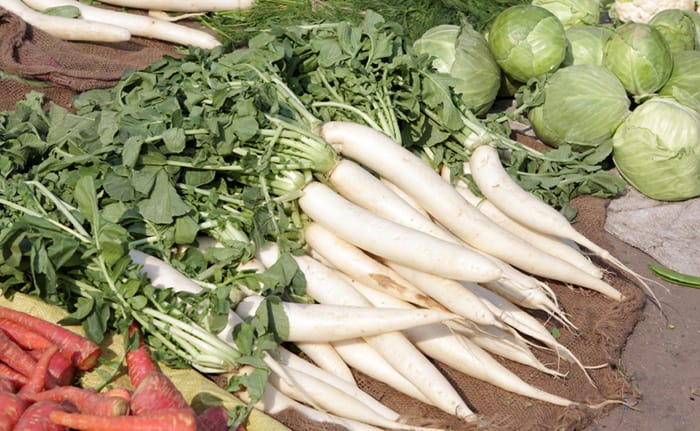
The first time I went to a market in Japan, the many unusual sights amazed me. Although I had been to Asian markets in the U.S. before, and even spent three weeks in China learning about food and nutrition, many things in Japan still left me in awe. Thankfully we had a tour guide who was happy to explain some of the stranger items. This was my first encounter with a sea pineapple (which not a fruit at all), crabs with legs as long as my arms, peaches the size of my head, lots of sea veggies and more kinds of mushrooms than I would ever know what to do with. But, if I had to pick any one thing from Japan that has amazed and captivated me most, it would be the daikon.
Ever heard of it? As far as I know it is gaining some popularity in the U.S. and can be found in many Asian markets. You may have even eaten some at a Japanese restaurant and never even realized it. So what is a daikon? It’s a Japanese radish. Why is it so interesting? It’s huge! There is no other way to say it. The daikon has to be the largest vegetable I have ever seen.
Not only is it long — with some extending to over two feet long — it is wide as well. There are a couple of different shapes of daikon, but the most common that I see resembles a carrot. Something else unique about the daikon? It is white. I think that is another quality that drew me in. So often we hear bad things about white foods, but that isn’t the case for the daikon. Since my first daikon encounter at the market I have come to respect this massive root vegetable.
To eat a daikon, I can tell you it is not best enjoyed the same as a carrot, despite looking like one. Most often in Japan this radish is pickled and served as a small side dish or as a garnish. Of course it can be cooked (often simmered) and eaten as an ingredient in dishes as well, just the same as any other radish or root veggie. Some bonuses to the daikon are that it is low in calories, high in fiber and also contains some vitamin C. If you are looking for some added nutrition, try out the leaves too. Daikon spouts are even available for sale in local Japanese grocery stores, so if you look hard enough in an Asian market, you might just stumble across this find.
Once you do find a daikon, if you aren't sure what to do with it and have no interest in pickled daikon, check out these options from Fruits and Veggies More Matters.
While I now love daikon, it wasn't love at first bit. At first I wasn’t a fan for one reason or another, but within a few weeks of living in Japan, I fully embraced this staple Japanese vegetable. Yes, I still giggle when I walk into a grocery store and see these giant radishes on display, but I know now that it is not as daunting as it first seemed. For more on the daikon and other traditional Japanese vegetables, check out the Eat Well Japan app I wrote for Eat Well Global, a series of country specific smart phone apps written by dietitians/nutritionists living in those countries designed to help travelers eat well.


